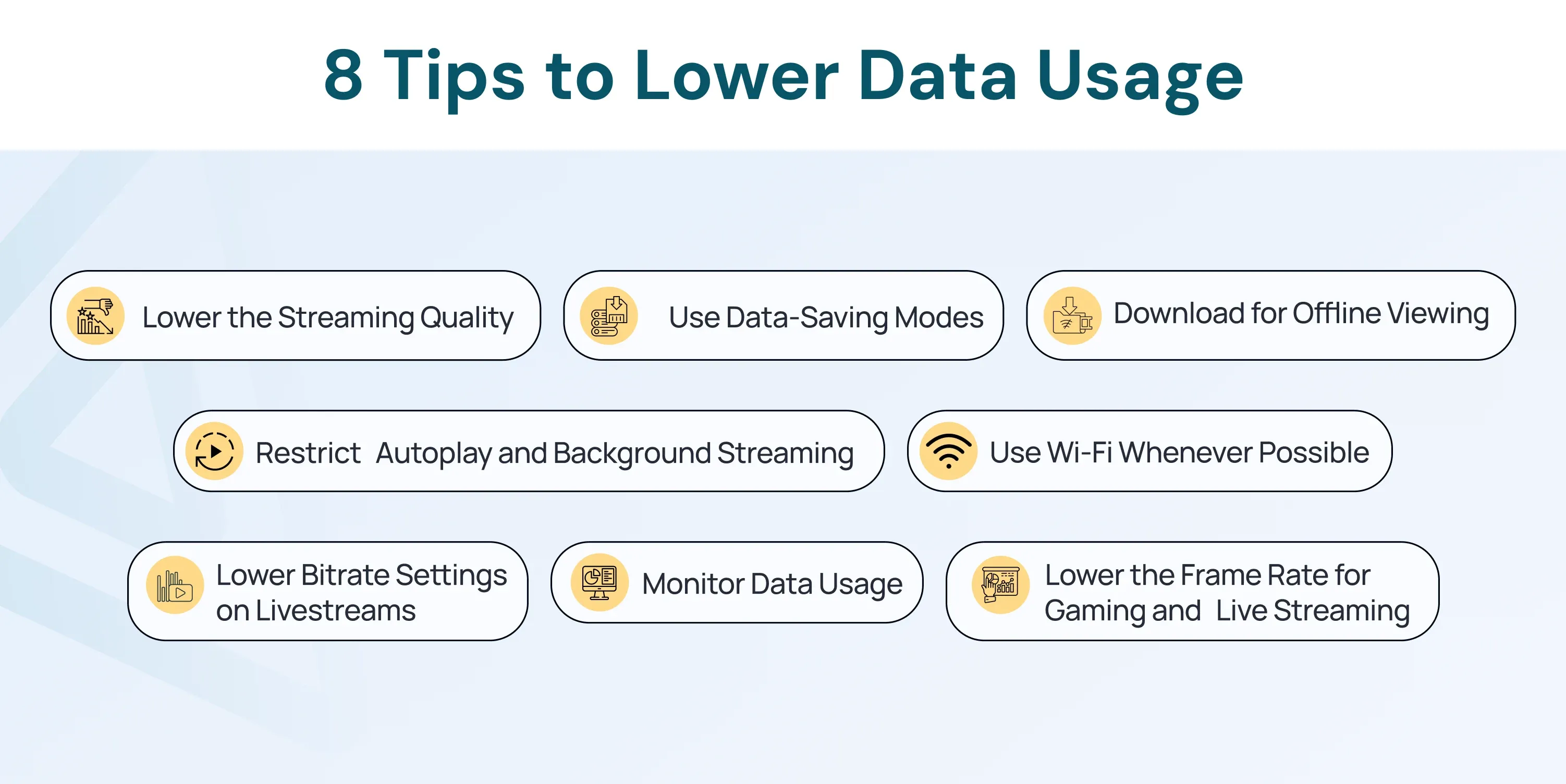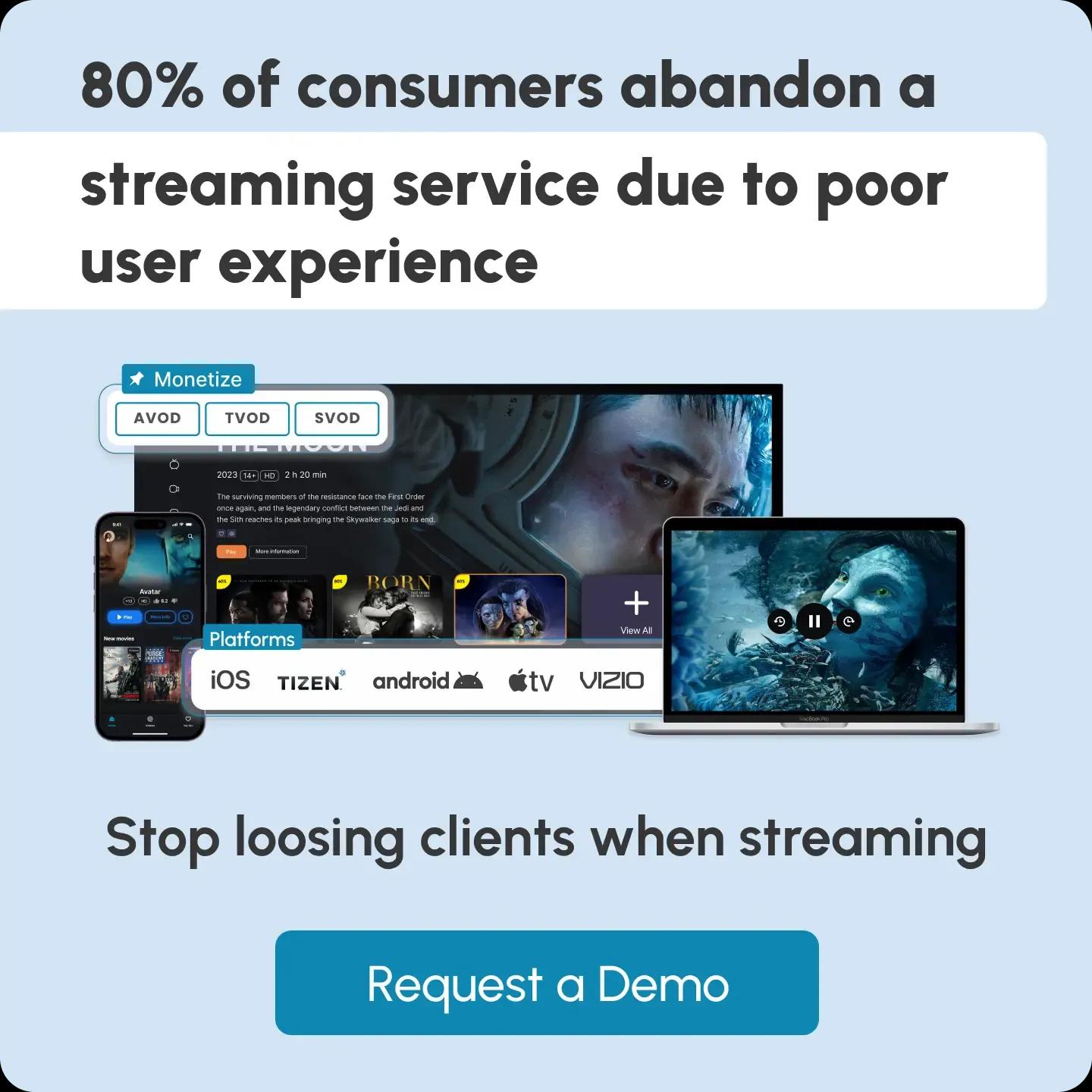
How Much Data Does Streaming Use, And How to Lower Data Usage
When watching on-demand content or streaming live, your data consumption can climb rapidly (which is not ideal), and not just because of the usage that you can see directly. This can lead to poor video quality, slow playback, and, therefore, a ruined streaming experience. To avoid this, you must know a thing or two about how data usage works during video streaming. And it isn’t as complicated as it may sound.
This guide explains how much data is required to stream video content and what the do’s and don’ts are for seamless streaming.
Let’s go through practical tips on how to maximize your usage and avoid going over your internet limits for the best streaming experience ever.
What is Data Usage?
Data usage refers to the amount of data your device sends to and receives from the internet over a specific period. It’s typically measured in megabytes (MB) or gigabytes (GB), and is often tracked by ISPs or mobile carriers to determine billing or data cap usage.
This includes all online activities like:
- Streaming videos or music
- Browsing websites
- Downloading or uploading files
- Using apps that connect to the internet
- Video calls and gaming
Data Usage in Streaming
Streaming is one of the main sources of daily entertainment. Therefore, it’s essential to understand what to expect when streaming any type of content.
Keep in mind that data usage can differ depending on several factors, including streaming quality, device type, and the technology different platforms use.
If you’re aware of all these factors, you can easily manage data usage and avoid surpassing your internet plan limits.
Streaming Quality
The resolution you choose or have for video streaming has the biggest impact on how much data you use.
Standard Definition (480p) content usually consumes between 700MB and 1GB per hour, making it the most data-friendly option for those with limited internet plans.
High Definition (720p) roughly doubles that usage at 1.5GB to 2GB per hour, offering clearer visuals.
Full HD (1080p) further increases consumption, using about 3GB to 4GB per hour, which is often the default resolution for laptops and desktops.
Ultra HD or 4K streaming is the most data-intensive, requiring anywhere from 7GB to 16GB per hour, depending on the platform, codec, and bitrate settings. This means just a few hours of 4K streaming can quickly eat up dozens of gigabytes.
Audio Streaming
While audio uses less data compared to video, quality differences can still add up over time. A standard music stream, such as one from Spotify’s default settings, uses about 50MB per hour, which is suitable for most casual listening.
However, switching to higher-quality formats like lossless or HD audio can raise this number to around 150MB per hour or more.
For podcast listeners or background music streaming throughout the day, the cumulative data usage can become significant (especially if playback is continuous for hours at a time). For this, platforms enable users to adjust audio quality for a balance between fidelity and data savings.
Bitrate and Its Impact
Bitrate refers to the amount of data transmitted per second, and it directly influences both the quality of the stream and the amount of data used.
A higher bitrate generally means better picture or sound quality, but it comes at the cost of higher data consumption.
Example:
A 1080p video streamed at 3Mbps will use less data than the same video streamed at 6Mbps, though the latter will look sharper.
To automatically adjust quality based on your internet speed, adaptive bitrate streaming is used. This helps prevent buffering while also optimizing data usage; however, it can sometimes result in noticeable shifts in resolution during playback.
Compression Technologies
By saying compression technologies, we refer to codecs.
A codec is a technology (software, hardware, or both) that compresses digital media (like video or audio) for transmission or storage and then decompresses it for playback.
The efficiency of the compression codec a streaming service uses plays a huge role in how much data is required to deliver high-quality content.
Advanced codecs like VP9 (used by YouTube) or AV1 (adopted by Netflix and newer platforms) are designed to retain sharp visuals while reducing the file size, making streaming more data-efficient.
On the other hand, older codecs such as H.264 are less efficient and tend to consume more data for the same level of quality. As streaming platforms transition to next-generation codecs, viewers can enjoy clearer video without significantly increasing their data usage. However, device compatibility also matters, since not all devices support newer codecs. This is why old codecs are still in use.
Autoplay, Preloading, and Background Streaming
Streaming platforms often come with convenience features like autoplay, which automatically starts the next episode or video, and preloading, which buffers content ahead of time.
While helpful, these features can lead to unnecessary data consumption if you’re not actively watching.
Example:
Leaving YouTube or Netflix running in the background can quietly consume gigabytes of data even when you’re not paying attention.
Pro Tip: Disable your autoplay and background streaming to avoid accidental overuse.
Another effective option is to download content for offline use. By downloading once and watching multiple times, you use significantly less data compared to streaming the same content repeatedly.
Device Influence
The type of device you use has a major effect on streaming data consumption.
Smartphones and tablets often use adaptive streaming technologies, which adjust resolution to match your current network speed. Many mobile apps also provide data-saving modes that limit resolution to reduce usage.
In contrast, laptops and desktops usually default to higher resolutions like 1080p or higher, which can increase data consumption unless you manually change settings.
Smart TVs and dedicated streaming devices (like Apple TV, Roku, or Fire TV Stick) are built to deliver HD and 4K content seamlessly, so these often lead to the highest data usage.
Similarly, gaming consoles such as PlayStation and Xbox use higher bitrates for both streaming platforms and cloud gaming services. Because cloud gaming streams game graphics in real time at resolutions up to 4K, it can consume as much (or even more) data than regular 4K video streaming.
Data Usage Breakdown by Streaming Quality
Here’s a table that’ll help you understand how much data streaming uses based on streaming quality.
| Streaming Quality | Bitrate (Approx.) | Data Usage per Hour |
|---|---|---|
| 144p (Very Low) | 80-100 Kbps | ~90MB |
| 240p (Low) | 300-500 Kbps | ~225MB |
| 360p (SD) | 500-1000 Kbps | ~500MB |
| 480p (Standard Definition) | 1-2 Mbps | 700MB - 1GB |
| 720p (High Definition) | 2.5-5 Mbps | 1.5GB - 2GB |
| 1080p (Full HD) | 5-8 Mbps | 3GB - 4GB |
| 1440p (Quad HD) | 10-16 Mbps | 6GB - 8GB |
| 4K (Ultra HD) | 15-25 Mbps | 7GB - 16GB |
Data Consumption in Live Streaming
Live streaming is trending, whether it’s social media streams, live sports, or gaming sessions. Compared with pre-registered content, live streaming transmits information in real time; therefore, it requires more internet bandwidth and data consumption.
 Several factors influence the amount of streaming data used, including the video stream's quality, bitrate, encoding tools, and the streaming platform.
Several factors influence the amount of streaming data used, including the video stream's quality, bitrate, encoding tools, and the streaming platform.
1. Video resolution and bitrate: The most considerable factors for the data usage during live streaming are resolution and bitrate.
More resolution means more data to be streamed for smooth and good quality. A standard 480p live stream might consume anywhere from 500MB to 1GB per hour, whereas you may easily find yourself using 1.5GB to 3GB per hour for 720p HD. The data consumption is around 3GB to 6GB per hour when you stream at 1080p (Full HD), while 4K Ultra HD live streaming can eat away 10GB to 20GB per hour.
As live streaming does not use the same compression techniques as are employed for on-demand video platforms, it often needs to use a much higher bitrate in order to deliver a similarly high quality.
2. Adaptive bitrate streaming: Dynamically adjusts the video resolution to the bandwidth, and is another key contributor to data usage.
Adaptive bitrate technology enables YouTube Live, Twitch, Facebook Live, and other platforms to deliver the best possible experience without buffering.
If you have a strong internet connection, the platforms will default to higher resolutions, which causes higher data usage. Users with smaller data plans should manually adjust their live streaming settings to conserve data.
3. Encoding and compressing data: The way the data has been encoded and compressed can affect how much of it you will use.
Pre-recorded videos are compressed extensively before streaming, lowering file sizes with little or no quality loss. Streaming to live streaming, on the other hand, requires encoding all live content, which can be highly inefficient.
If it’s done so, platforms may use older codecs (H.264, for example), which are less efficient and require more data, while more recent technologies like AV1 or HEVC (H.265) provide much lower data consumption.
4. Platform settings and frame rate: Data usage is also impacted by streaming platform settings and frame rate.
Twitch, for instance, gives users the option of streaming at either 30fps or 60fps, with increasing frame rates taking a greater toll on bandwidth. Additionally, live streams with interactive elements, such as live chat, overlays, and real-time reactions, can increase data usage due to the need for more processing to support these elements when used in tandem with the video feed.
5. The device type: Data consumption partially depends on the type of device you use to live stream.
A smartphone typically uses less data per stream than a computer because of the screen size and mobile-optimized settings. Live streaming from a PC, gaming console, or smart TV generally uses more data than a mobile device because of the greater video processing power these devices have at their disposal, as well as default settings optimized for high-quality video streaming.
How to Reduce Streaming Data Usage

1. Lower the Streaming Quality
Many streaming services enable their users to change video resolution. Lowering the quality from 1080p to 720p or to 480p can save data considerably.
inoRain has a good idea about how to optimize settings for better streaming data management. Click here to learn more.
2. Use Data-Saving Modes
You can find most major apps, such as Netflix, YouTube, and Spotify, with built-in data-saving modes that automatically reduce bitrate and resolution. Give these settings a try for a minimum. usage.
3. Download for Offline Viewing
Rather than streaming over and over, download movies, shows, or music while you’re on Wi-Fi. So it avoids unnecessary data consumption while on mobile networks.
4. Restrict Autoplay and Background Streaming
Disable autoplay on sites like YouTube, Netflix, and so on to prevent videos from triggering due to accidental clicks. (And turn off background streaming in mobile apps so data isn’t being used if you’re not actually watching.)
5. Lower Bitrate Settings on Livestreams
For anything pre-recorded, like videos, you can lower the resolution; for live streams, you can manually reduce the bitrate or resolution if watching/broadcasting. Many platforms default to the highest quality, consuming more data.
6. Use Wi-Fi Whenever Possible
Instead of using cellular data, connect to a stable Wi-Fi network. When using public Wi-Fi, do so safely via a VPN.
7. Monitor Data Usage
Look at your internet provider’s data usage tracker, as well as apps available to monitor streaming usage and track how much data is being consumed.
8. Lower the Frame Rate for Gaming and Live Streaming
Streaming at 30fps instead of 60fps can save a ton of data usage, which can matter significantly with live streams or cloud gaming services.
Data Usage of Popular Streaming Services
There is a high chance you’re using one of these streaming services. So, let’s see how much data is used for each.
Here’s a table comparing the estimated data usage of popular streaming services based on different video quality settings:
| Streaming Service | Low (480p or SD) | Medium (720p or HD) | High (1080p or Full HD) | Ultra HD (4K) |
|---|---|---|---|---|
| Netflix | ~0.7GB per hour | ~3GB per hour | ~5GB per hour | ~7-16GB per hour |
| YouTube | ~0.5GB per hour | ~1.5GB per hour | ~3GB per hour | ~7-15GB per hour |
| Amazon Prime Video | ~0.7GB per hour | ~2GB per hour | ~5GB per hour | ~7-14GB per hour |
| Disney+ | ~0.6GB per hour | ~2.5GB per hour | ~5GB per hour | ~7-16GB per hour |
| Hulu | ~0.65GB per hour | ~1.5GB per hour | ~3GB per hour | ~7-15GB per hour |
| HBO Max | ~0.7GB per hour | ~3GB per hour | ~5GB per hour | ~7-16GB per hour |
| Twitch (Live Streaming) | ~0.4GB per hour | ~1.8GB per hour | ~4GB per hour | ~10-20GB per hour |
The 3 Main Tips to Lower Your Data Usage Today
By this point, you’ve explored everything about data usage in streaming. We want to give you the most valuable information, saving you time and an irreparable headache; the best three tips to lower your data usage.
1. Lower the Quality When You Don’t Need 4K
Ultra HD streams can eat up 7–16GB per hour. Switch to HD or even SD when you’re on mobile or don’t need crystal-clear detail—your eyes won’t notice much, but your data plan will.
2. Download Instead of Streaming Again and Again
Most platforms let you download shows and movies for offline viewing. Watching offline uses data only once, instead of burning through gigabytes every time you hit replay.
3. Use Data-Saving Features and Turn Off Autoplay
Enable your streaming app’s data saver mode to automatically cap resolution and bitrate. Also, disable autoplay, so you don’t waste data on videos you never intended to watch.
These tips will work best for individuals who just want to watch their late-night movie without having a single worry about using a crazy amount of data.
But if you’re looking for a solution that’ll lower data usage on a whole platform level, you need a different approach.
And for that, inoRain is here to help you out. We specialize in OTT solutions that’ll cover any of your streaming needs. This includes the P2P (peer-to-peer) technology, which allows you a great advantage: Lower Data Usage.
Exactly what you need, right? Take the first step towards cost-efficient and low-data-usage streaming.
Let inoRain help you scale up with the right tools and expertise.
Frequently Asked Questions
Co-founder / CTO
Armen is the CTO and Co-Founder of inoRain OTT and Co-Founder of HotelSmarters, specializing in advanced streaming technologies, OTT strategy, and interactive TV systems. He builds scalable end-to-end video delivery solutions and drives technical innovation across hospitality and streaming platforms, bridging complex engineering with practical business impact.

How to Develop a Video Streaming App: Best Practices
Learn the basics of developing a modern video streaming app. This guide covers key best practices to help you build the right way from the start.

How to Make a Short Video App (2026 Complete Guide)
Learn how to build a short video app in 2026. Explore micro-drama trends, key features, monetization models, and step-by-step development insights.

OTT Advertising: Types, Best Practices, and Strategies
Over-the-top (OTT) advertising has transformed how brands connect with consumers.

